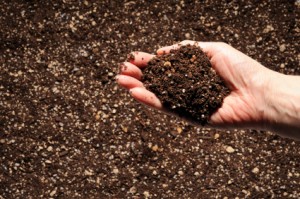When it comes to survival gardening, it all begins with dirt. Once you’ve gotten yourself completely off the grid, you might be generating enough electricity to consider hydroponics. Until that time, you’re stuck with good old-fashioned dirt if you’re looking for a reliable medium to grow your veggies in good times, bad times, and worse times.
For such an essential substance, dirt sure takes a beating in the English language. If you look the word up in your standard dictionary, odds are good that three out of four of the first definitions aren’t going to sound too friendly. You’ll see phrases like “any foul or filthy substance” or “moral filth” or “something or someone vile, mean, or worthless.” I guess that’s why a lot of gardening books and articles refer to the stuff beneath your feet as soil or earth.
Call it what you will, but good dirt is the heart of a good garden.
 To fully appreciate how valuable your dirt really is, it helps to know how long it took to become the magic stuff it actually is. Scientists tell us that it took millions of years of weathering to break big rocks down into the small pieces that form the basic ingredient in dirt. The size and chemical composition of those pieces or particles is determined, in large part, by the type of rock that got beaten down by the weathering process. Without going into a whole lot of geological explanations, it is safe to say that the soil you’ve got depends on what type of rocks you’ve got in your neighborhood.
To fully appreciate how valuable your dirt really is, it helps to know how long it took to become the magic stuff it actually is. Scientists tell us that it took millions of years of weathering to break big rocks down into the small pieces that form the basic ingredient in dirt. The size and chemical composition of those pieces or particles is determined, in large part, by the type of rock that got beaten down by the weathering process. Without going into a whole lot of geological explanations, it is safe to say that the soil you’ve got depends on what type of rocks you’ve got in your neighborhood.
Those little, tiny particles of rocks have a great bearing on your soil structure. Basically, there are three types of particles: clay, sand, and silt. In most places, dirt is made up of all three types but, like a lot of things in life, the proportion of the particles can make a big difference.
If you’ve got a nice even balance between the three, you’re lucky enough to have yourself a lot of loam. We like loam. It is easy to work and becomes your veggies’ best friend with a little organic matter and the regular application of Protogrow and some water. In an ideal world, every patch of dirt would be loam.
Protogrow – Plan Food That Virtually Eliminated The Need For Harsh Chemical Fertilizers…
Since we don’t live in an ideal world, you’re likely to have extensive spots in your yard where one particle dominates the other two.
Most common in my neck of the woods is clay soil. Dirt in which clay particles are in the majority sticks together. If you roll it between your fingers, it forms a sausage shape, or if you’re artistically inclined, a ball. While it is usually pretty rich in plant nutrients, it gets very sticky when wet and is so darn dense that there is little room for air or root growth. To make matters just a tad worse, when water displaces what little air there is between the clay particles, it hangs around for days and your plants drown. When clay soil dries, you’re in for a whole different adventure. The stuff turns hard as a rock, making digging a thankless task.
If you’re stuck with big patches of clay soil, you’re going to want to wait until you’ve had a few days of dry weather before working on improving it. Working wet clay dirt is an invitation to disaster, as it tends to clump together into clods that become virtual boulders when they dry out. When you can get to work, bust up the clay and mix in a decent amount of organic material. The more compost you have on hand for this project, the better. I’d advise going at least a half a foot deep in your first organic material improvement. Be patient, as it takes time, and you may even have to do this more than once to get some nice dirt going in that patch.
If the air spaces in clay dirt are too small, the air spaces in sandy soil are just way too big. When water hits the sandy stuff, it just dives down as far as it can. Now, you might not think water is much of a diver, but it can usually sink down way beyond the reach of plant roots in sandy soil. Of course, this problem is even worse in the spring when you’re trying to get young plants started. Those little tiny roots know there is water around somewhere, but if they are planted in sandy dirt, that precious moisture is usually lurking way beyond their reach.
As water runs through sandy soil like grass through a goose, it creates an additional problem for your plants as it washes away the few nutrients such dirt actually has. Trying to grow young veggies in unimproved sand is a losing proposition; those that don’t die of thirst will starve. It is not a pretty sight.
Fortunately, sandy soil is pretty easy to fix and, unlike improving clay, you won’t have to break your back doing it. Just mix in some leaf mold or another low fertility soil improver a few weeks before you plan to plant that patch. This will help the soil retain water and nutrition. A few days before adding your plants, you should mix in some organic material soaked with some diluted Protogrow and let the patch sit. Go about six inches deep on both these operations, and you should be able to grow some tasty and nutritious vegetables in that spot this year.
Silty dirt feels kind of silky when you rub it between your fingers. Although some folks describe the texture as soapy, this soil will leave your fingers dirty. It is somewhere between clay and sand yet not quite as good as loam. It can be a bit heavy to work. You can usually cure silty soil by mixing in some organic material and letting the patch rest for a few weeks. Before you plant that spot, loosen the soil up a bit and you should be good to go. Silty soil is usually pretty fertile, so mild treatment with a balanced organic fertilizer is usually enough to get you a good crop.
Well, that’s about it for this week. Drop by again soon when I’ll be talking a bit more about that ever-important stuff beneath your feet and how to get it to work best for you and your vegetables. Until then, I’d like to wish you and yours a lot of fun playing in the dirt as you develop your survival garden.
©2012 Off the Grid News
 Off The Grid News Better Ideas For Off The Grid Living
Off The Grid News Better Ideas For Off The Grid Living




